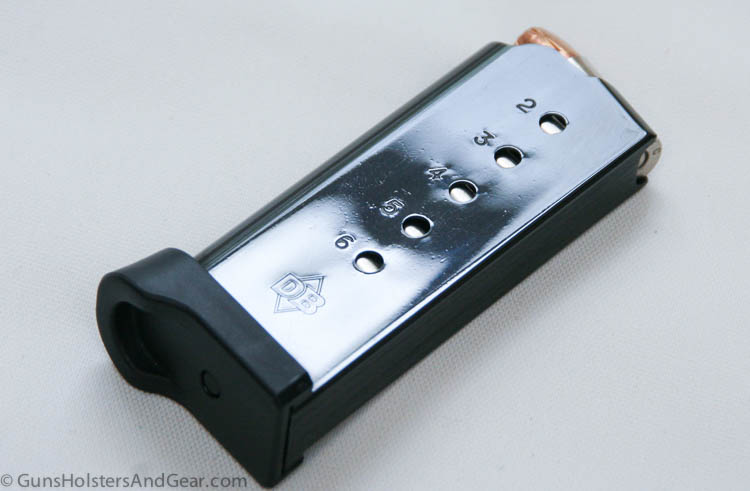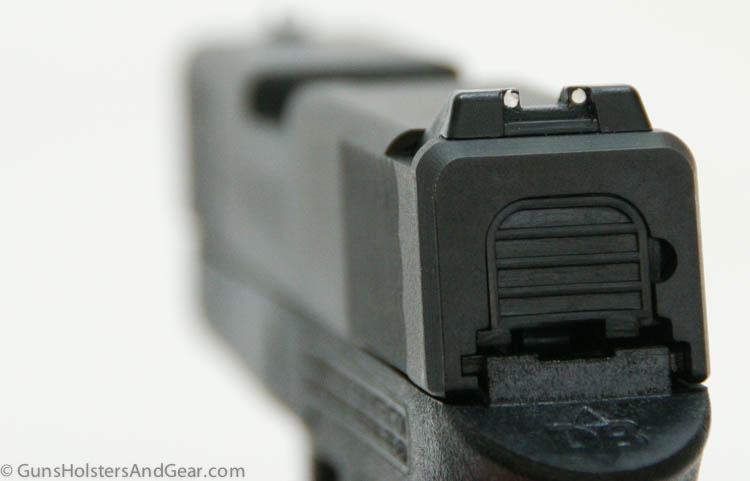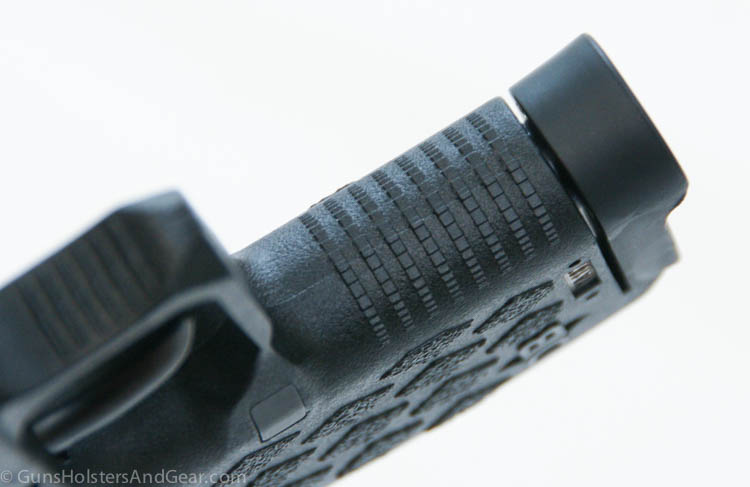The decade of the 9mm? Maybe. I’ve seen a lot of new 9mm carry guns introduced in recent years. Following a couple of decades of exotic round development, the 9mm seems to be regaining in popularity with many people for both self-defense and law enforcement use.
Special Note
Since I wrote this article, Diamondback Firearms redesigned the DB9 pistol. Potentially problematic issues, including the lack of a slide stop, tiny sights and the use of standard pressure ammunition only, have all been corrected or improved.
Check out my Diamondback DB9 Gen 4 review for additional information.
This article takes a look at the original Diamondback DB9 pistol. I originally examined this handgun in 2011, but have since updated the article several times to include additional information and experiences with the handgun. As such, this article is likely to be the most comprehensive and longest-term look at the original gun anywhere.
General Information
At its core, the DB9 is a polymer-framed, subcompact 9mm handgun. Based on its size, it appears to be angling to be one of the easiest to conceal 9mm handguns. An extremely small handgun has both benefits and drawbacks – this Diamondback is no different. It is a compromise of competing interests.

The double-action-only pistol is striker-fired. This isn’t terribly surprising, as many (most?) new pistol designs hitting the market seem to be continuing this trend.
The DAO trigger pull measured 6 pounds, 9 ounces on an average of 10 pulls. Diamondback lists the trigger pull as five pounds. The pull was long but smooth. I found it to be better than both the Ruger LCP and the Smith & Wesson Bodyguard 380.

The DB9 uses six-round magazines, giving the shooter a total of seven rounds on tap. The gun ships with only one magazine. The MSRP of the pistol is $431, a relatively modest price, but large enough that I would think the pistol would ship with two mags.
An aggressive texture pattern is on the pistol’s grip. It is not painful, though with long range sessions it can wear a little on the hands.
Size Matters
The 9mm Diamondback weighs only 11 ounces unloaded making it one of the lightest 9mm pistols on the market. A very light handgun can be more prone to felt recoil and malfunctions – you will want to skip down to the range time section below for more information on these topics.

At only 0.80″ wide, the DB9 is one of the thinnest semi-automatic pistols on the market. The pistol virtually disappears in a pocket or on an ankle.
The DB9 still manages to squeeze a 3″ barrel into the package. Overall length of the gun is only 5.6″ and the height is 4″ with the magazine inserted.

There are no external controls on the DB9, which contributes to the flatness of the gun. The lack of external controls means there are less things to foul the draw from concealment. The downside is the DB9 does not have a slide stop.
Interestingly, the DB9 is fairly close in size to the Ruger LCP. Yet, the DB9 is chambered in a more powerful caliber. Take a look at these photos for a comparison to the LCP:

…and…

…and finally…

Sights
Sights on the Diamondback DB9 are not bad for a pistol this small, but they are not without their downsides.

The front sight is a hard plastic ramp with a surprisingly visible white square. To say it is a “low profile” sight is an understatement, yet the white square was much more visible that I had expected it would be. It is not a miracle product, however, and it is less visible than the front sight of a duty-sized handgun.
The rear sight is also a hard plastic with a wide, shallow notch. On either side of the notch are small white dots. The rear sight is dovetailed and is drift adjustable.

This may not be a significant concern to you, but the rear sight is sloped in such a way that it could not be used for one-handed slide manipulation. The odds are pretty remote that you would ever need to use it in this manner, but it is worth consideration.
I don’t care for three-dot sights due to the unnecessary visual complexity they present for shooting under high stress. However, with the front sight being a white square, it is visually different and larger than the rear sight dots. It tends to draw the eye to it.

For target shooting, the sights are good enough to keep rounds in a 4″ circle at 7+ yards. The sights on a small Kahr like the CM9 are better, but the DB9 sights are an infinitely better system than what is on the Ruger LCP. Regardless, I suspect they might be too small to be seen in combat.
Ammunition Selection
The Diamondback is rated only for standard pressure 9mm ammunition. Firing +P and +P+ ammunition will void the warranty on the DB9. With such a small firearm, sacrifices have to be made. Presumably, to be this thin and light the gun will not stand up to the repeated firing of the higher pressure rounds.

Additionally, Diamondback does not recommend any bullet sizes larger than 124 grain. This is likely due to heavier bullets, like the 147-grain bullets, that tend to have lower slide velocities. While most 9mm bullet weights above 124 grains tend to be 147-grain projectiles, there are a few other heavies like the Hornady 135 grain Critical Duty and the Federal 135 grain Hydra-Shok loads.
This limits the Diamondback to a narrower range of ammunition for personal protection, but there are still some very good choices. Speer offers their 115 grain and 124 grain Gold Dot loads in standard pressure. Federal offers 115 grain JHP, 124 grain Hydra-Shok and 124 grain HST bullets in standard pressure loads. Winchester, Remington, Corbon and others all make good self-defense ammo that will work fine in the Diamondback.
For my money, I’d go with the standard pressure 124 grain Gold Dot or HST rounds.
The standard pressure 9mm compares very favorably to the most frequent pocket gun: the snub nose .38 revolver. The .38 Special snubs typically have barrels around 2″ and in even +P loadings will typically be 100 fps slower than the 9mm in a similar bullet weight.
Range Time
During my time with the DB9, I did a moderate amount of dry firing and put hundreds of rounds through the gun at the range across several trips.
Although the gun is very thin, I was able to grip the gun and maintain a solid hold on the pistol while shooting. The gun feels a bit odd in the hand with it feeling longer than it should be for its width.

Even with the aggressive grip texture, unless I had a crush grip on the pistol, it would wiggle and cause a significant change in finger placement on the trigger. The slight extension on the bottom of the magazine worked very well to keep the pinky on the gun.
Recoil was not inconsequential, but not nearly as bad as I had anticipated. By way of comparison, I felt recoil was much softer than the Taurus 709 and 740 sub-compact pistols, and slightly easier to control than that the Ruger LCP. The Smith & Wesson M&P Shield and the Glock 43 are both much easier to control than the DB9.

Shooting more than 100 rounds at a time is probably more than most people will want to tackle. At about 200 rounds, I would imagine even experienced shooters would be done, or perhaps even picking up a small flinch.
Reliability
Reliability was flawless – the DB9 digested every kind of ammo I stuffed in the magazine without any stoppages. In my initial evaluation, I ran both FMJ and JHP style bullets through the gun including standard pressure Federal HST and Speer Gold Dot (both 124 grain bullets). Everything worked as it should.
Subsequently, I’ve run additional tests on the pistol with at least nine additional loads. These loads were again a mix of JHP and FMJ rounds in both 115 grain and 124 grain varieties. Reliability remained 100%.

Even though Diamondback suggests that bullets weighing more than 124 grains may cause cycling issues, I ran a box (20 rounds) of Hornady’s standard pressure 135 grain Critical Duty ammunition through the gun. The DB9 ran the ammo without any problem whatsoever.
Ammunition Performance
During my initial testing of the gun, my chronograph had gone down on me. Since that time, I replaced it and ran the below loads across it to measure velocity. Unfortunately, at this time some of the loads like the Gold Dot and HST were not available to me for testing.
| Velocity | Energy | |
| Blazer Brass 115 gr FMJ | 1,062 fps | 288 ft-lbs |
| Federal Champion 115 gr FMJ | 1,058 fps | 286 ft-lbs |
| Hornady Critical Duty 135 gr FTX | 932 fps | 260 ft-lbs |
| HPR Ammunition 115 gr JHP | 1,030 fps | 271 ft-lbs |
| HPR Ammunition 124 gr JHP | 928 fps | 237 ft-lbs |
| Perfecta 115 gr FMJ | 1,039 fps | 276 ft-lbs |
| Remington UMC Target 115 gr MC | 1,041 fps | 277 ft-lbs |
| Remington UMC 115 gr JHP | 1,059 fps | 286 ft-lbs |
| Winchester USA (white box) 115 gr JHP | 1,048 fps | 280 ft-lbs |
Drawbacks
There are things I really like the DB9 but did find two drawbacks that annoyed me. The first was the lack of a slide stop. Without a slide stop, it is impossible to lock the slide to the rear. Combined with a stiff recoil spring, this can create a challenge – especially for new shooters.
While I would like to have a slide stop, I also understand that adding one increases the width of the gun. Consider it a compromise, but one I’m not happy with.
The second thing I dislike about the DB9 is the magazine release. I found the recessed button was difficult to access, and releasing the magazine was a slow process. I suppose the upside is you are not likely to release the magazine accidentally while carrying or shooting the gun.
Additional drawbacks to the gun include the relatively small sights, long trigger pull that is heavier than advertised and the harsh recoil. However, all of these things are balanced by the very compact size of the pistol and its absolute reliability during testing.
Final Thoughts
This was my first experience with a Diamondback pistol. I have not shot the DB380, which is the predecessor to the DB9. I was not sure what to expect when the gun arrived, nor what to expect over the long term that I’ve evaluated the pistol.

I was very pleased with the performance of the Diamondback DB9. The gun has performed flawlessly. It does have its drawbacks (see above,) but it worked every time I pulled the trigger.
The DB9 is chambered in a serious caliber, and even though it is restricted to standard pressures, the 9mm is still a step up from the .380 ACP.
I think the DB9 makes a good pocket or ankle gun. Personally, I would carry it as a back up gun instead of as a primary concealed carry gun. However, with seven rounds on tap, it is likely to suffice in most armed encounters.
Last update: June 17, 2022
Disclosure
In this article, I wrote about a pistol that was provided to me by Diamondback without charge and for the express intent of testing and evaluation. No one at Diamondback or elsewhere asked or suggested that I do a “positive” evaluation of the firearm.
At no time have I been in any discussions with Diamondback or Taurus for either of them to be an advertiser or sponsor of this site.
This article was originally written in 2011 and was substantially updated in June of 2015. The conclusions have remained the same, though some of the wording was changed to make the article easier to read. (Hey, I’ve improved my writing a little…)
GunsHolstersAndGear.com is a for-profit website. I do not charge readers a dime to access the information I provide.
Some of the links on this page and site are affiliate links to companies like Amazon and Palmetto State Armory. These links take you to the products mentioned in the article. Should you decide to purchase something from one of those companies, I make a small commission.
The links do not change your purchase price. I do not get to see what any individual purchases.
